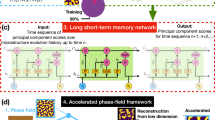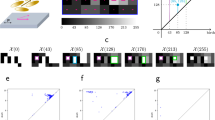Abstract
Dynamic self-consistent field theory (DSCFT) is a fruitful approach for modeling the structural evolution and collective kinetics for a wide variety of multicomponent polymers. However, solving a set of DSCFT equations remains daunting because of high computational demand. Herein, a machine learning method, integrating low-dimensional representations of microstructures and long short-term memory neural networks, is used to accelerate the predictions of structural evolution of multicomponent polymers. It is definitively demonstrated that the neural-network-trained surrogate model has the capability to accurately forecast the structural evolution of homopolymer blends as well as diblock copolymers, without the requirement of “on-the-fly” solution of DSCFT equations. Importantly, the data-driven method can also infer the latent growth laws of phase-separated microstructures of multicomponent polymers through simply using a few of time sequences from their past, without the prior knowledge of the governing dynamics. Our study exemplifies how the machine-learning-accelerated method can be applied to understand and discover the physics of structural evolution in the complex polymer systems.
Similar content being viewed by others
References
Thurn-Albrecht, T.; Schotter, J.; Kastle, C. A.; Emley, N.; Shibauchi, T.; Krusin-Elbaum, L.; Guarini, K.; Black, C. T.; Tuominen, M. T.; Russell, T. P. Ultrahigh-density nanowire arrays grown in self-assembled diblock copolymer templates. Science 2000, 290, 2126–2129.
Meuler, A. J.; Hillmyer, M. A.; Bates, F. S. Ordered network mesostructures in block polymer materials. Macromolecules 2009, 42, 7221–7250.
Müller, M.; Abetz, V. Nonequilibrium processes in polymer membrane formation: theory and experiment. Chem. Rev. 2021, 121, 14189–14231.
Huang, C. H.; Zhu, Y. Y.; Man, X. K. Block copolymer thin films. Phys. Rep. 2021, 932, 1–36.
Fraaije, J. G. E. M.; van Vlimmeren, B. A. C.; Maurits, N. M.; Postma, M.; Evers, O. A.; Hoffmann, C.; Altevogt, P.; Goldbeck-Wood, G. The dynamic mean-field density functional method and its application to the mesoscopic dynamics of quenched block copolymer melts. J. Chem. Phys. 1997, 106, 4260–4269.
Morita, H.; Kawakatsu, T.; Doi, M. Dynamic density functional study on the structure of thin polymer blend films with a free surface. Macromolecules 2001, 34, 8777–8783.
Müller, M.; Schmid, F. Incorporating fluctuations and dynamics in self-consistent field theories for polymer blends. Adv. Polym. Sci. 2005, 185, 1–58.
Wang, G.; Ren, Y.; Müller, M. Collective short-time dynamics in multicomponent polymer melts. Macromolecules 2019, 52, 7704–7720.
Sides, S. W.; Fredrickson, G. H. Parallel algorithm for numerical self-consistent field theory simulations of block copolymer structure. Polymer 2003, 44, 5859–5866.
Hall, D. M.; Lookman, T.; Fredrickson, G. H.; Banerjee, S. Hydrodynamic self-consistent field theory for inhomogeneous polymer melts. Phys. Rev. Lett. 2006, 97, 114501.
Zhang, L.; Sevink, A.; Schmid, F. Hybrid lattice Boltzmann/dynamic self-consistent field simulations of microphase separation and vesicle formation in block copolymer systems. Macromolecules 2011, 44, 9434–9447.
Arora, A.; Qin, J.; Morse, D. C.; Delaney, K. T.; Fredrickson, G. H.; Bates, F. S.; Dorfman, K. D. Broadly accessible self-consistent field theory for block polymer materials discovery. Macromolecules 2016, 49, 4675–4690.
Mehta, P.; Wang, C.-H.; Day, A. G. R.; Richardson, C.; Bukov, M.; Fisher, C. K.; Schwab, D. J. A high-bias, low-variance introduction to machine learning for physicists. Phys. Rep. 2019, 810, 1–124.
Carleo, G.; Cirac, I.; Cranmer, K.; Daudet, L.; Schuld, M.; Tishby, N.; Vogt-Maranto, L.; Zdeborová, L. Machine learning and the physical sciences. Rev. Mod. Phys. 2019, 91, 045002.
Brunton, S. L.; Noack, B. R.; Koumoutsakos, P. Machine learning for fluid mechanics. Annu. Rev. Fluid Mech. 2020, 52, 477–508.
Keith, J. A.; Vassilev-Galindo, V.; Cheng, B.; Chmiela, S.; Gastegger, M.; Müller, K. R.; Tkatchenko, A. Combining machine learning and computational chemistry for predictive insights into chemical systems. Chem. Rev. 2021, 121, 9816–9872.
Colen, J.; Han, M.; Zhang, R.; Redford, S. A.; Lemma, L. M.; Morgan, L.; Ruijgrok, P. V.; Adkins, R.; Bryant, Z.; Dogic, Z.; Gardel, M. L.; de Pablo, J. J.; Vitelli, V. Machine learning active-nematic hydrodynamics. Proc. Natl. Acad. Sci. U. S. A. 2021, 118, e2016708118.
Li, H.; Jin, Y.; Jiang, Y.; Chen, J. Z. Y. Determining the nonequilibrium criticality of a Gardner transition via a hybrid study of molecular simulations and machine learning. Proc. Natl. Acad. Sci. U. S. A. 2021, 118, e2017392118.
LeCun, Y.; Bengio, Y.; Hinton, G. Deep learning. Nature 2017, 521, 436–444.
Carrasquilla, J.; Melko, R. G. Machine learning phases of matter. Nat. Phys. 2017, 13, 431–434.
Bapst, V.; Keck, T.; Grabska-Barwińska, A.; Donner, C.; Cubuk, E. D.; Schoenholz, S. S.; Obika, A.; Nelson, A. W. R.; Back, T.; Hassabis, D.; Kohli, P. Unveiling the predictive power of static structure in glassy systems. Nat. Phys. 2020, 16, 448–454.
Zhao, S.; Cai, T.; Zhang, L.; Li, W.; Lin, J. Autonomous construction of phase diagrams of block copolymers by theory-assisted active machine learning. ACS Macro Lett. 2021, 10, 598–602.
Coli, G. M.; Boattini, E.; Filion, L.; Dijkstra, M. Inverse design of soft materials via a deep learning-based evolutionary strategy. Sci Adv. 2022, 8, eabj6731.
Aoyagi, T. Deep learning model for predicting phase diagrams of block copolymers. Comput. Mater. Sci. 2021, 188, 110224.
Tu, K.; Huang, H.; Lee, S.; Lee, W.; Sun, Z.; Alexander-Katz, A.; Ross, C. A. Machine learning predictions of block copolymer self-assembly. Adv. Mater. 2020, 32, 2005713.
Schneider, L.; de Pablo, J. J. Combining particle-based simulations and machine learning to understand defect kinetics in thin films of symmetric diblock copolymers. Macromolecules 2021, 54, 10074–10085.
Pathak, J.; Hunt, B.; Girvan, M.; Lu, Z.; Ott, E. Model-free prediction of large spatiotemporally chaotic systems from data: a reservoir computing approach. Phys. Rev. Lett. 2018, 120, 024102.
Raissi, M.; Perdikaris, P.; Karniadakis, G. E. Physics-informed neural networks: a deep learning framework for solving forward and inverse problems involving nonlinear partial differential equations. J. Comput. Phys. 2019, 378, 686–707.
Zhao, H.; Storey, B. D.; Braatz, R. D.; Bazant, M. Z. Learning the physics of pattern formation from images. Phys. Rev. Lett. 2020, 124, 060201.
Bar-Sinai, Y.; Hoyer, S.; Hickey, J.; Brenner, M. P. Learning data-driven discretizations for partial differential equations. Proc. Natl. Acad. Sci. U. S. A. 2019, 116, 15344–15348.
Kemeth, F. P.; Bertalan, T.; Thiem, T.; Dietrich, F.; Moon, S. J.; Laing, C. R.; Kevrekidis, I. G. Learning emergent partial differential equations in a learned emergent space. Nat. Commun. 2022, 13, 3318.
Vlachas, P. R.; Byeon W.; Wan, Z. Y.; Sapsis, T. P.; Koumoutsakos, P. Data-driven forecasting of high-dimensional chaotic systems with long short-term memory networks. Proc. R. Soc. A 2018, 474, 20170844.
Vlachas, P. R.; Arampatzis, G.; Uhler, C.; Koumoutsakos, P. Multiscale simulations of complex systems by learning their effective dynamics. Nat. Machine Intelligence 2022, 4, 359–366.
Montes de Oca Zapiain, D., Stewart, J. A.; Dingreville, R. Accelerating phase-field-based microstructure evolution predictions via surrogate models trained by machine learning methods. NPJ Comput. Mater. 2021, 7, 1–11.
Hu, C.; Martin, S.; Dingreville, R. Accelerating phase-field predictions via recurrent neural networks learning the microstructure evolution in latent space. Comput. Methods Appl. Mech. Engrg. 2022, 397, 115128.
Qi, S.; Schmid, F. Dynamic density functional theories for inhomogeneous polymer systems compared to brownian dynamics simulations. Macromolecules 2017, 50, 9831–9845.
Pearson, K. On lines and planes of closest fit to systems of points in space. Philos. Mag. 1901, 2, 559–572.
Jolliffe, I. T. Principal Component Analysis; Wiley: Chichester, U.K., 2002.
Hochreiter, S.; Schmidhuber, J. Long short-term memory. Neural Comput. 1997, 9, 1735–1780.
Greff, K.; Srivastava, R. K.; Koutnik, J.; Steunebrink, B. R.; Schmidhuber, J. LSTM: a search space odyssey. IEEE Trans. Neural Netw. Learn. Syst. 2017, 28, 2222–2232.
Cho, K.; Van Merriënboer, B.; Bahdanau, D.; Bengio, Y. On the properties of neural machine translation: encoder-decoder approaches. 2014, arXiv preprint arXiv:1409.1259.
Cho, K.; Van Merriënboer, B.; Gulcehre, C.; Bahdanau, D.; Bougares, F.; Schwenk, H.; Bengio, Y. Learning phrase representations using RNN encoder-decoder for statistical machine translation. 2014, arXiv preprint arXiv:1406.1078.
Bray, A. J. Theory of phase-ordering kinetics. Adv. Phys. 1994, 43, 357–459.
Sung, L.; Karim, A.; Douglas, J. F.; Han, C. C. Dimensional crossover in the phase separation kinetics of thin polymer blend films. Phys. Rev. Lett. 1996, 76, 4368.
Siggia, E. D. Late stages of spinodal decomposition in binary mixtures. Phys. Rev. A: At., Mol., Opt. Phys. 1979, 20, 595–602.
Shiwa, Y.; Taneike, T.; Yokojima, Y. Scaling behavior of block copolymers in spontaneous growth of lamellar domains. Phys. Rev. Lett. 1996, 77, 4378.
Bahiana, M.; Oono, Y. Cell dynamical system approach to block copolymers. Phys. Rev. A: At., Mol., Opt. Phys. 1990, 41, 6763.
Yokojima, Y.; Shiwa, Y. Ordering process in quenched block copolymers at low temperatures. Phys. Rev. E: Stat. Phys., Plasmas, Fluids, Relat. Interdiscip. Top. 2000, 62, 6838.
Singh, M.; Wu, W.; Nuka, V.; Strzalka, J.; Douglas, J. F.; Karim, A. Late stage domain coarsening dynamics of lamellar block copolymers. ACS Macro Lett. 2021, 10, 727–731.
Acknowledgments
This work was financially supported by the National Natural Science Foundation of China (Nos. 22073028, 21873029 and 22073004) and the Fundamental Research Funds for the Central Universities.
Author information
Authors and Affiliations
Corresponding authors
Ethics declarations
The authors declare no interest conflict.
Electronic Supplementary Information
Rights and permissions
About this article
Cite this article
Zhang, KH., Jiang, Y. & Zhang, LS. Inferring the Physics of Structural Evolution of Multicomponent Polymers via Machine-Learning-Accelerated Method. Chin J Polym Sci 41, 1377–1385 (2023). https://doi.org/10.1007/s10118-023-2891-9
Received:
Accepted:
Published:
Issue Date:
DOI: https://doi.org/10.1007/s10118-023-2891-9




